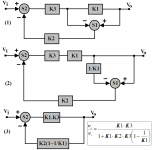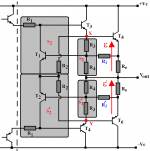jcx said:Hi Mikes, re Post #1338:
...more informative to my mind is moving R9_1 ( “inverting input” of U2 viewed as a diff amp) left of the test source V1, this tests the loop gain the “controller” consisting of U1 and U2 is applying around the E1 output stage...
Find out about how overall loop-transmission (gain if you prefer) is correctly determined in a multi-''touching''-loop system, here.
janneman said:
Hi Tom,
I downloaded your circuit but when I open it I get an error messags saying 'cannot find OP275' and then in the diagram the output amp is missing (which I assume is an OPA541?). I have the OPA541 .sub (the one Heinz posted).
Any idea what I am missing?
Jan Didden
Jan,
I'm sorry about that. In the older version that I started from, I had accidentally used an in-house OP275.ASY symbol, for the OPA541. You should be able to go into the opamps library and grab the "opamp2" device and then right-click on it, click the Value field, enter OPA541E in the upper dialogue/edit field, and click OK. Then you should have the OPA541E using the Opamp2.asy symbol, which is included with LT-Spice.
- Tom Gootee
janneman said:
Mike I hope I get some time this weekend to look at your analysis. I agree that the 'actual' ec loop gain is somehow proportional to the extracted error but hadn't realised the equation was so neat.
Nice work, thanks!
Jan Didden
Thanks Jan.
It does make sense, if one thinks about it.
When the output stage produces no error at all, then it must be of exactly unity-gain.
This means the summer used to extract error from this ideal output stage cannot now generate output, since both its inputs are at exactly the same potential.
Therefore, the loop's transmission drops to zero.
This is what you correctly referred to as FOD.
I honestly cannot improve on this explanation for the benefit of jcx et al.

mikeks said:
Thanks Jan.
It does make sense, if one thinks about it.
When the output stage produces no error at all, then it must be of exactly unity-gain.
This means the summer used to extract error from this ideal output stage cannot now generate output, since both its inputs are at exactly the same potential.
Therefore, the loop's transmission drops to zero.
This is what you correctly referred to as FOD.
I honestly cannot improve on this explanation for the benefit of jcx et al.
One thing to consider is that in the math, the loop gain is still there. I have the feeling that the reason for this is that we concentrate too much on the case where the summer product is '1' and then the non-linear gain block drops out. Maybe another approach is to assume that the gain block is exactly '1' and see what drops out then, possibly independent from the summers gain product. Maybe that gives another insight (my gut feeling is that then the loop gain drops out or drops to '1'). I can't check it right now unfortunately.
Jan Didden
A suggestion. How about moving on from this proliferation of contradictory posts? The poor horse is dead. Wouldn't it be more useful to apply your efforts to proposing improvements to Bob's output stage?
I've given you the simulation model and the key performance graphs. Why not think about how to improve its performance and make some objective suggestions?
Brian
I've given you the simulation model and the key performance graphs. Why not think about how to improve its performance and make some objective suggestions?
Brian
traderbam said:A suggestion. How about moving on from this proliferation of contradictory posts? The poor horse is dead. Wouldn't it be more useful to apply your efforts to proposing improvements to Bob's output stage?
I've given you the simulation model and the key performance graphs. Why not think about how to improve its performance and make some objective suggestions?
Brian
Well sure, go ahead. I for one am not very much motivated to try to improve Bob's circuit.
On the other hand, this IS the ec thread. Maybe split off a thread on 'Improving Bob's power amp'?
Jan Didden
janneman said:
One thing to consider is that in the math, the loop gain is still there. I have the feeling that the reason for this is that we concentrate too much on the case where the summer product is '1' and then the non-linear gain block drops out. Maybe another approach is to assume that the gain block is exactly '1' and see what drops out then, possibly independent from the summers gain product. Maybe that gives another insight (my gut feeling is that then the loop gain drops out or drops to '1'). I can't check it right now unfortunately.
Jan Didden
Good point Jan!
You'll notice that the condition for which my argument is valid is at balance when the summers are of exactly unity gain, so that the error extracted from the output stage, and transferred to its input, remains of exactly the same magnitude, but with 180 degrees phase shift.
Clearly, when you stray from this balance condition, however slightly, the expression for loop gain given here no longer applies; error-cancellation cannot then be said to occur, here and here.
mikeks said:[snip]Clearly, when you stray from this balance condition, however slightly, the expression for loop gain given here no longer applies; error-cancellation cannot then be said to occur.
Yes but what happens if you assume that 'A' = 1? Then again there is no error and the summer gain becomes immaterial, right? Again, no loop transmission.
Jan Didden
We can visualize what happens by returning to the block diagrams below, previously given here.
With respect to the transfer function, Vo/Vi, when K2=K3=1, then Vo/Vi=1.
If, on the other hand, K1=1, and K1, K2 are not necessarily unity, then Vo/Vi=K3.
With respect to the transfer function, Vo/Vi, when K2=K3=1, then Vo/Vi=1.
If, on the other hand, K1=1, and K1, K2 are not necessarily unity, then Vo/Vi=K3.
Attachments
mikeks said:We can visualize what happens by returning to the block diagrams below, previously given here.
With respect to the transfer function, Vo/Vi, when K2=K3=1, then Vo/Vi=1.
If, on the other hand, K1=1, and K1, K2 are not necessarily unity, then Vo/Vi=K3.
What I'm getting at, if K1 and K3 are 1 (no non-linearity I presume), then K2 is immaterial, and again, there is no loop transmission. So, whether there is an error or not, there is no loop transmission of the SIGNAL. Only the error, if it is present. So I can't see the infinite loop.
Jan Didden
Jan,
I'm not sure what work you do or what you are working on but you have mentioned publishing something on this subject. In the most well-meaning way, I strongly urge you to have your calculations and reasoning verified independently by someone you trust who has appropriate mathmatics or control theory ability before you publish anything.
Brian
I'm not sure what work you do or what you are working on but you have mentioned publishing something on this subject. In the most well-meaning way, I strongly urge you to have your calculations and reasoning verified independently by someone you trust who has appropriate mathmatics or control theory ability before you publish anything.
Brian
traderbam said:Jan,
I'm not sure what work you do or what you are working on but you have mentioned publishing something on this subject. In the most well-meaning way, I strongly urge you to have your calculations and reasoning verified independently by someone you trust who has adequate mathmatics or control theory ability before you publish anything.
Brian
Is that an offer? I would take it!
Jan Didden
Jan, it wasn't an offer but I am pleased to be asked and will review your work to the best of my ability. Email me when you are ready. BrianIs that an offer? I would take it!
Mike wrote:
How about explaining explicitly why you think this is an improvement? It is not obvious from your link. I notice you have now introduced current feedback.A speculative modification of Hawksford's scheme is shown below.
- Home
- Amplifiers
- Solid State
- Bob Cordell Interview: Error Correction


